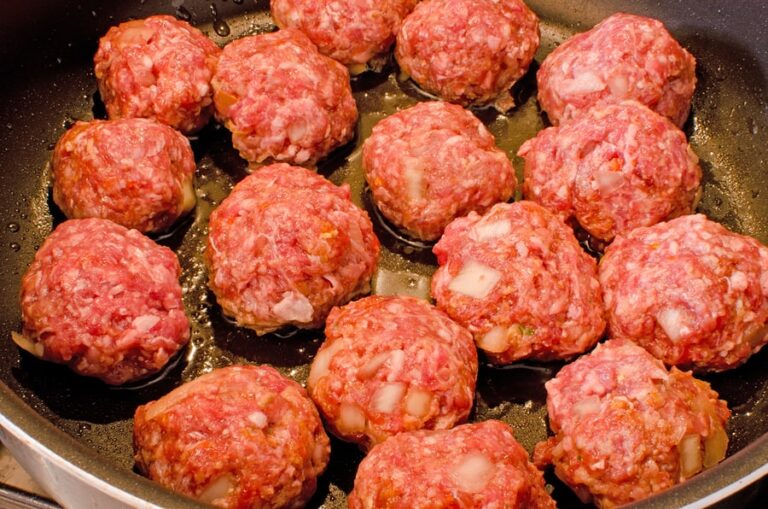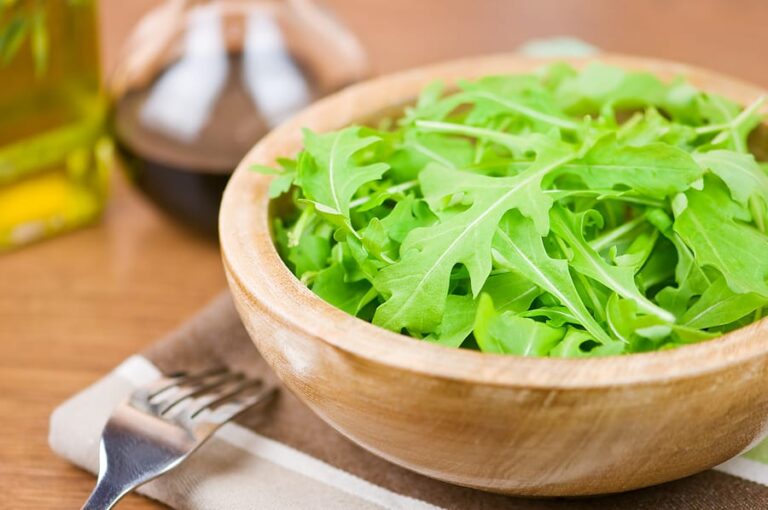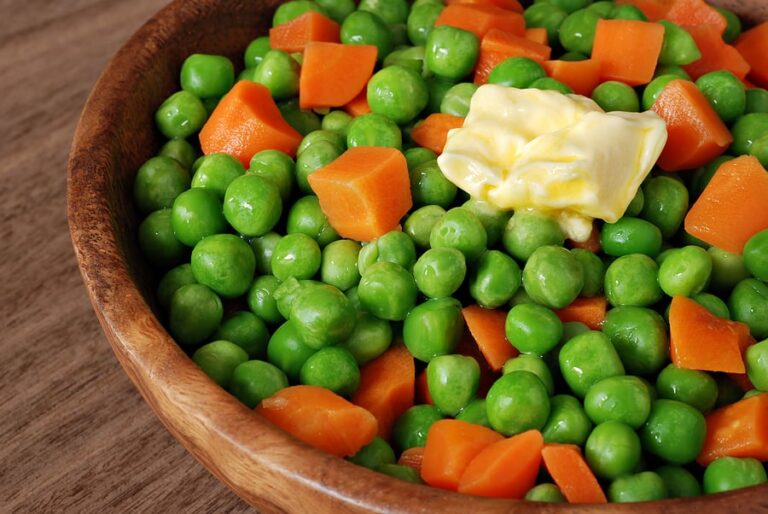How to Make Fresh Pasta with No Recipe

Fresh pasta is easily made at home—with no recipe. All you need is all-purpose flour, eggs, salt, and a few drops of water. It is delicate and rich flavored and excellent with light sauces–butter and Parmesan cheese, or olive oil, garlic and parsley, or cream and bacon bits, or tomato sauce with an herb or two just picked from the garden.
Fresh pasta is best when served as its own flavor ingredient, as both a companion and partner to the sauce. Fresh pasta and its sauce complement one another. (Dried pasta—made from semolina flour, water, and salt—is easily stored dry because it contains no eggs. Choose dried pasta less for its inherent flavor—no eggs, no rich flavor–and more for its texture and strength; match dried pasta with robust, hearty sauces.)
You can make fresh pasta by hand—mixed, rolled and cut—in an hour or so. Making fresh pasta by hand is the traditional way—the way it’s done in northern Italy. But, you can also make fresh pasta with a machine or two—you won’t save much time, but in the end the cut pasta will have a more finished look. To understand, appreciate, and “feel” fresh pasta, make it by hand at least once or twice.
Ratio: Fresh pasta dough is always made with 3 parts flour and 2 parts egg, the ratio is 3 : 2.
One large-size egg weighs about 2 ounces; one cup of flour weighs about 5 ounces.
Use one large-size egg for each full serving you want to make, to that add 1 ½ the egg’s weight in flour. (You can do this with a simple kitchen scale.)
If you don’t have a scale, use 2 eggs per 1 cup of flour to make 1 serving.
You can make one pound of fresh pasta with 2 cups of flour and 3 eggs. One pound of fresh pasta is enough pasta for 3 or 4 main course servings, 4 to 6 first course servings, and enough pasta to make 25 to 30 ravioli.
Ingredients: Here’s what you will need to make fresh pasta:
- Eggs: Eggs separate fresh pasta from dried pasta; eggs enhance the color and richness of fresh pasta; they make the dough more cohesive and firm; they are usually the only source of water for fresh pasta. Eggs allow fresh pasta to be cooked more quickly than dried pasta.
- Flour: Use unbleached all-purpose flour or unbleached and organic all-purpose flour (bleached flour will make stickier dough). For dough with some texture, mix about half and half all-purpose flour and whole-grain flour: to make whole wheat pasta substitute whole wheat for half the all-purpose flour; to make buckwheat pasta substitute a bit more than half the all-purpose flour with buckwheat flour; for a flavorful and not too grainy pasta substitute half the all-purpose flour with semolina flour (semolina is made from the inner part of the grain of hard durum wheat, when ground it is called durum semolina). Flour has a high gluten content which gives the pasta resiliency and allows it to cook al dente, tender but somewhat firm.
- Salt: one teaspoon to make a pound of pasta.
- Water: You will likely need a teaspoon or two of water
- Optional Color and Flavorings: Vegetables and herbs can be added to pasta dough for coloring and herb flavor. You can flavor pasta with almost any herb: use about ½ cup fresh herb leaves for each pound of pasta you are making. The herbs will be chopped and added at mixing time or can be added between sheets of pasta just before they pass through the pasta machine. Pasta can be colored with the addition of pureed vegetables at mixing time. Spinach pasta—green pasta—is perhaps the most common. Red or pink pasta can be made with tomatoes, red peppers, or beets.
How to make fresh pasta without a recipe:
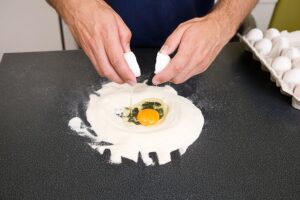
Step One: Mixing flour and eggs.
You will need a work space to mix the flour and eggs—use a clean flat counter top or cutting board, a surface where you will be able to roll the dough into thin sheets.
Begin by combing the flour and eggs: place the flour in a mound on the work top or in a large bowl. Use the back of your hand to create a well or depression in the flour and add the salt.
Into the well you will add and mix the eggs. Break an egg and begin to mix it into the flour—use your fingers or a fork or spoon, stirring as if you were making scrambled eggs. Add gradually and evenly the remaining eggs as you mix combing the eggs and flour. (You can break the eggs into a separate work bowl and beat them to mix the yolks and whites before adding them to the flour if you like.)
Your goal is to mix the flour and eggs until they are blended into a loose mass. You want to mix all of the flour with the eggs. Add an egg and beat, add an egg and mix—until the flour and eggs are evenly combined. (If the mix does not seem even, you may need to adjust the consistency of the dough: if the dough is to dry or stiff, add a few drops of water; if the dough is too loose or watery, add a bit more flour. Temperature and humidity in the kitchen can cause slight variations in the consistency of the dough; adjust your mix as you go.)
Adding optional coloring and flavoring of pasta: Fresh pasta has a delicate flavor that deserves to be highlighted when served—not overpowered. Add coloring and flavoring to complement fresh pasta, not so much to enhance it. If you want to add color and herb flavor to fresh pasta, do it now—while you are mixing the dough.
Chopped fresh herbs are easily added to fresh pasta dough. Add parsley, marjoram, or thyme—about a quarter cup for a pound of pasta, or add rosemary or sage—about two tablespoons for a pound of pasta. Chop the fresh herb leaves fine, and add them to the mix.
Spinach pasta (green) and tomato pasta (pinkish-red) are favorites. The vegetables don’t add much flavor to the pasta—just vivid colors. To make spinach pasta, clean the spinach and remove the stems then sauté the spinach in butter (a quarter pound of spinach for a pound of pasta) until tender; cool, squeeze, chop fine as possible, and blend the spinach with the eggs—replace one of the eggs from your mix. For red or orange pasta, do the same with tomatoes, beets, roasted red bell peppers, or carrots. For golden pasta add a pinch or two of saffron or extra egg yolks.
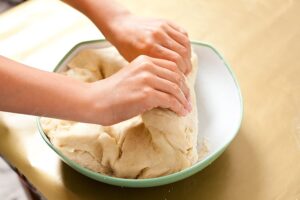
Step Two: Knead the dough.
Once the flour and eggs are combined, knead the dough to create a fine texture and sturdy structure. Place the dough onto a lightly floured surface and use your hands to knead lightly—work from the center outward, kneading to form a smooth firm ball. Press the dough with the heel of your hand and fold it over; repeat–heel, fold, heel, fold, heel, fold—until the dough is smooth, about 5 to 10 minutes, not more than 20 minutes.
If there is too little moisture in the dough, the dough will be crumbly and stiff and hard to knead; add water by the half-teaspoonful until the consistency improves. If the dough is too moist, it will be tacky, sticky, and slack—and it will lack strength when cooked.
The objective of kneading is to make the dough evenly moist throughout, to develop the gluten structure of the dough–giving it both texture and elasticity. The best way to do this is to feel the dough as you knead. Feel it grow smooth as the gluten aligns. Your goal is to create pasta dough with a velvet-like texture. Experience is the best guide for determining when the proper consistency has been reached.
Step Three: Relax the dough.
Once the dough has become smooth and elastic, gather it into ball or disk, cover it with a towel or plastic wrap, and allow it to sit—to rest and relax. Resting allows the flour particles to continue to fully absorb the egg moisture; this is essential to develop the gluten structure, to make the dough cohesive and firm which is essential for rolling and cutting. Covering the dough as it rests ensures that the moisture does not evaporate. The flour must fully absorb the moisture before it is rolled into thin sheets and cut into ribbons. Let the dough rest for at least 10 minutes, longer is better—even up to an hour.

Step Four: Rolling and cutting the dough.
Once the dough has relaxed, it is ready to be rolled and cut. On a lightly floured work surface, flatten the ball of dough with your hands and divide it into equal parts. The divided whole will give you small batches that are easier to roll and cut. Roll and cut each small batch separately; cover the batches you are not working with a towel or plastic wrap so they stay moist.
Pasta can be rolled and cut by hand or you can use a pasta machine:
To roll and cut the dough by hand: Use a rolling pin to begin. Work from the center of the dough to the edges, rolling the dough outward. Roll the dough out, turn it, dust it with flour, and roll it again. Roll the dough into sheets; roll the dough to the thickness you want keeping in mind that pasta expands when cooked.
Once the dough has been rolled into sheets (12 inch by 12 or 16 inch sheets might be a good starting point), you can cut the dough with a sharp knife into the style pasta you want: linguine—thin, long, and flatted; fettuccine—thick, flat and ribbon shaped; lasagna—long, flat, and wide; small squares to make filled pastas such as ravioli. Sheets of dough waiting to be cut should be lightly floured so that they do not stick together as they wait their turn.
Rolling and cutting the dough by hand will make for irregular but interesting surfaces and cuts. These irregularities will add character to the pasta and let the sauce adhere more closely to the pasta.

To roll and cut the dough by machine: Your pasta machine should be firmly clamped to the work surface or counter before you begin. Flatten by hand each batch of dough to a thickness that can be guided through the rollers of the pasta machine. Set the rollers to the widest opening and begin to guide the dough through the machine, lightly flouring the dough (and your fingers) as necessary to prevent it from sticking. The dough will be rolled to a long, wide ribbon.
Once through, fold each ribbon of dough into thirds, set the machine to the next narrowest setting, and guide one end of the folded ribbon through the roller—the folded ribbon will unfold as it is drawn into the machine. Repeat this process creating ever thinner sheets of rolled dough, rolling until the sheets are nearly translucent. Once you have reached the desired thickness, your ribbons of dough can be cut into 12- to 16-inch-long sheets that can be hand cut to make the pasta you want or passed through the appropriate cutting blades of your pasta machine. Sheets or dough should be floured before they are stacked so that they do not stick.
- Fettuccine or tagliatelle: roll dough thin and cut with wide cutting rollers.
- Taglierini: roll dough thin and cut with narrow cutting rollers.
- Papardelle: cut by hand, using a fluted cutting wheel into long noodles about ¾ wide.
- Tonnarelli: roll dough to the same thickness as the width of the narrow cutting roller; cut with the narrow cutting rollers; the result is square spaghetti.
- Bow ties: cut into rectangles 1 ½ x 3 inches. Pinch the middle to make a bow.
- Lasagna: cut by hand into broad strips about 8 to 12 inches.
- Ravioli and tortelli: cut the dough in squares or circles—about 3 inches across. Add water to the dough to make it slightly moister by adding water to seal the edges and keep the stuffed dough from cracking.
Cooking fresh pasta:
Fresh pasta can be cooked as soon as it has been cut; if you don’t plan to cook it right away, cover it with wax paper or plastic wrap and refrigerate it.
Fresh pasta should be cooked quickly—in just 3 to 6 minutes; don’t let it linger in boiling water. Cook fresh pasta in a generous pot of rapidly boiling salted water so that the noodles do not stick together. Fresh pasta already contains a lot of moisture so it will not need to linger in the boiling water. Fresh pasta is done when it is cooked through but still has a bite—al dente, meaning “to the tooth,” just a bit of bite. Pay attention to the pot, the flour in fresh pasta can cause boilovers in just a minute or two.
Serving fresh pasta–in simple ways:
Serve fresh pasta with a delicate sauce that will allow the flavor of the pasta to come through. Avoid bold flavors that will overwhelm fresh pasta.
- Top with butter and Parmigiano-Reggiano.
- Top with tomato sauce–such as puttanesca, or meat sauce.
- Toss with olive oil and Parmigiano-Reggiano.
- Toss with cream and dried bacon.
- Top with butter and creamed spinach.
- Top lasagna sheet with meat sauce and roll as a single serving.
Storing fresh pasta:
- Fresh pasta dough can be refrigerated for an hour and up to 24 hours before rolling—sprinkle flour across the sheets of dough and cover with a light towel or plastic wrap. If you refrigerate fresh pasta then re-knead the dough for 3 to 5 minutes before rolling.
- Cut fresh pasta can be bagged and frozen for up to a month.
- Because fresh pasta is made with eggs, remember it is highly perishable, unlike dried pasta.
To mix dough in a food processor or electric mixer:
Fresh pasta can be made with a food processor or electric mixer (using a processor or mixer may be advantageous if you are mixing more than 4 cups of flour): Place ingredients in the bowl of the processor fitted with a paddle attachment or dough hook. Pulse mix until blended on low or medium speed—as little as 15 seconds; until the dough forms a smooth ball that pull cleanly away from the bowl’s side. Do not over process. When the dough comes together, turn it out and knead by hand.


